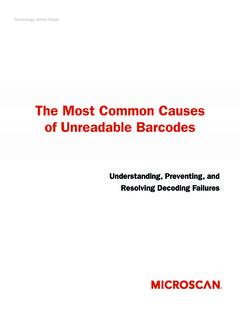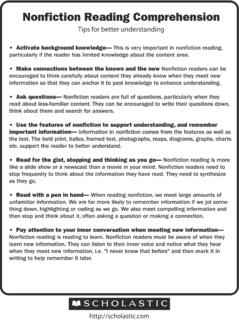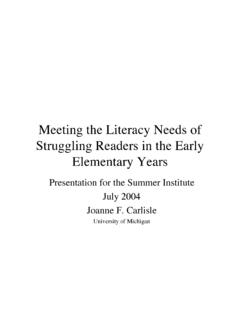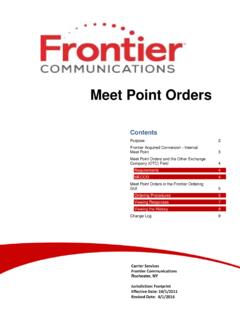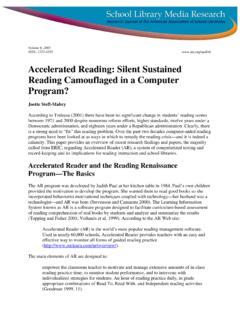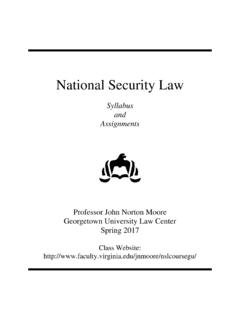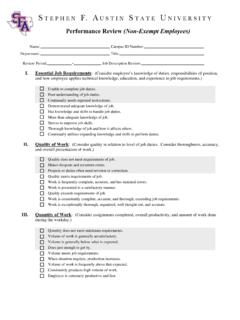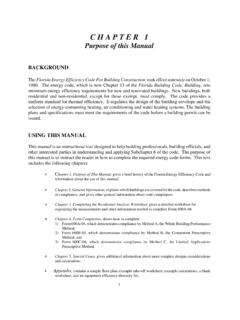Transcription of Guidelines for Choosing Text-to-Speech or Read Aloud for ...
1 Text-to-Speech and Read Aloud Decision Guidelines Page 1. Guidelines for Choosing Text-to-Speech or Read Aloud for Smarter Balanced ELA. Summative and Interim Assessment Reading Passages for Students with Disabilities in Grades 3-5. July 13, 2015. The decision to provide a student in grades 3-5 with Text-to-Speech or human read- Aloud accommodations for the English language arts (ELA) reading assessment passages is a significant decision, one that has possible long-term implications for the child. These accommodations are defined as follows: Text-to-Speech : Text is read Aloud to the student via embedded Text-to-Speech technology. The student is able to control the speed as well as raise or lower the volume of the voice via a volume control.
2 Read Aloud : Text is read Aloud to the student by a trained and qualified human reader who follows the administration Guidelines provided in the Smarter Balanced Test Administration Manual and Read Aloud Protocol in the Manual's appendix. Readers may read Aloud some or all of the content to students. The decision about providing either of these accommodations should be guided by a set of questions to determine whether it is appropriate to provide the Smarter Balanced ELA. reading passages via the embedded Text-to-Speech accommodation or the non - embedded human reader accommodation. Background In designing the Smarter Balanced assessments, states agreed on the claims that the assessments were to The reading claim, Claim #1, is: Students can read closely and analytically to comprehend a range of increasingly complex literary and informational texts .
3 For students in grades 3-5, the Smarter Balanced ELA reading claim integrates the ability to read and the ability to understand what was read. Providing ELA reading passages via Text-to-Speech or a human reader to students who do not meet specific criteria2 means that these combined skills are not being assessed, and no conclusions can be reached about the student's skills in these areas. 1. The claims are identified in the content specifications for the Smarter Balanced ELA/Literacy assessment. The content specifications document is available at , under Content Specifications. 2. The Smarter Balanced ELA reading assessment allows Text-to-Speech and read Aloud for directions and ELA items as designated supports available to all students with documented needs.
4 It also now allows Text-to-Speech and read Aloud for ELA reading passages for those students with IEPs (Individualized Education Programs) that document the need for these accommodations for ELA reading passages (see the updated Guidelines at content/uploads/2014/08 or students/support-for-under-represented-s tudents/.). Text-to-Speech and Read Aloud Decision Guidelines Page 2. There is minimal research on the numbers of students with disabilities in grades 3-5. who might need Text-to-Speech or read Aloud assistance because of a disability that interferes with their ability to learn to decode and comprehend text. Some states have suggested that from 1% to of their total student population may have a disability that severely limits or prevents them from decoding written text, while others indicate that the numbers are much smaller or much larger.
5 These students may be those who are blind or have significant visual impairments but have not learned to read braille, and those students who have disabilities that have significant decoding or fluency Because grades 3-5 are a critical time for students to learn to read and grow in their comprehension skills, it is important to obtain a good measure of these skills. Providing the Text-to-Speech and read Aloud accommodations to students who do not need them because of their identified reading disability can have negative consequences for instruction and for their growing decoding and comprehension skills. For example, some educators might assume that students who receive the Text-to-Speech or read Aloud accommodation no longer need to be instructed on decoding and fluency skills, which is a clearly inappropriate assumption.
6 Only those students for whom it is appropriate to provide the Smarter Balanced ELA. reading assessment passages through Text-to-Speech or read Aloud accommodations should receive them. Further, for those students receiving the read Aloud accommodation, it is critical that the reader adhere to the Smarter Balanced Read Aloud Guidelines . The Guidelines are available at: The questions provided here are ones that can assist Individualized Education Program (IEP) decision-making teams in determining whether it is appropriate to indicate that students in grades 3-5 should be provided the reading passages for an ELA reading assessment via a Text-to-Speech or human read Aloud accommodation. The questions should be answered by the student's teachers, and by the student himself or herself.
7 Then, the IEP team can consider both the provided answers, along with other diagnostic information to make a decision about the provision of Text-to-Speech or read Aloud accommodations for the Smarter Balanced ELA reading assessment. A tool for documenting the responses to questions is provided in Table 1. Questions for Teachers 1. Is this student blind or does this student have a significant visual impairment? If so, is the student learning to read braille? 3. Your state should be keeping track of the number of students receiving the Text-to-Speech or read Aloud accommodation for ELA reading passages. It will provide additional professional development and guidance if it appears that too many or too few students may be using the accommodation for the Smarter Balanced ELA reading assessment passages.
8 Text-to-Speech and Read Aloud Decision Guidelines Page 3. A student who is learning to read braille should be assessed in grades 3-5 with the braille form of the assessment, so that an accurate measure of his or her reading and comprehension skills is obtained. If the student has not learned to read braille, providing the Smarter Balanced ELA reading assessment passages through text to speech or read Aloud is appropriate. 2. Does the student have a reading-based disability? Does the disability affect the student's decoding skills, fluency skills, or comprehension skills? A reading-based disability may affect a student's ability to decode, read with fluency, understand text that is decoded, or a combination of these.
9 Determining the nature of the student's reading challenges can help determine the appropriate intervention approaches, as well as needed accommodations during classroom instruction and during assessments. Having a reading-based disability means that there is strong evidence of the persistence of the disability despite intensive, targeted instruction. There should be documentation of the interventions used and formative assessment data on the effect of each intervention. Evidence of a reading-based disability should have been documented in grades K-2, and reflected in such difficulties as difficulty learning letters or letter sounds, difficulty in learning sight words, and difficulty in phoneme blending. These and other data (for example, student work) should be reviewed by the IEP team to consider the access effects of the use of the accommodation.
10 The Text-to-Speech or read Aloud accommodation is meant to provide access to the text, not to make up for being a slow reader . Being a slow reader does not mean that the student should receive the Text-to-Speech or read Aloud accommodation for the Smarter Balanced ELA reading assessment in grades 3-5. 3. Is the student an English language learner (ELL)? An English language learner is a student who is learning how to read at the same time that he or she is learning English. It is important to obtain an accurate measure of his or her decoding and skills in English as the student learns the language, which may take several years. Thus, being an ELL is not a sole reason to receive Text-to-Speech or a read Aloud accommodation for the Smarter Balanced ELA reading passages.
